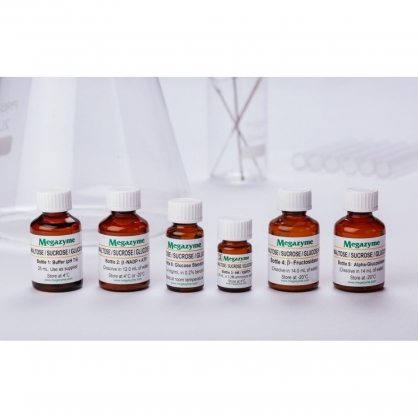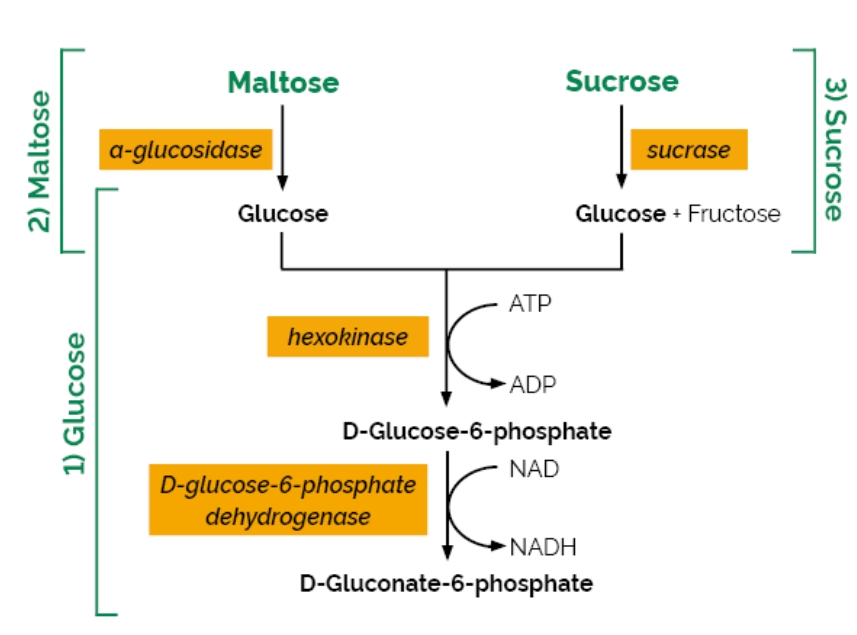- 操作流程-葡萄糖和蔗糖 PROCEDURE (for D-glucose and sucrose)
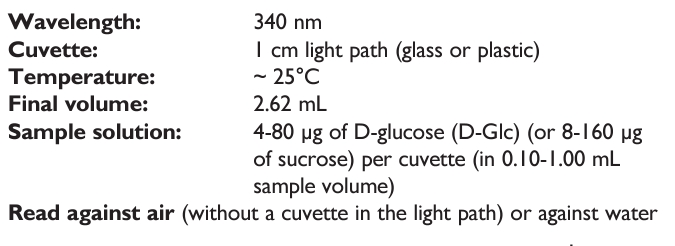
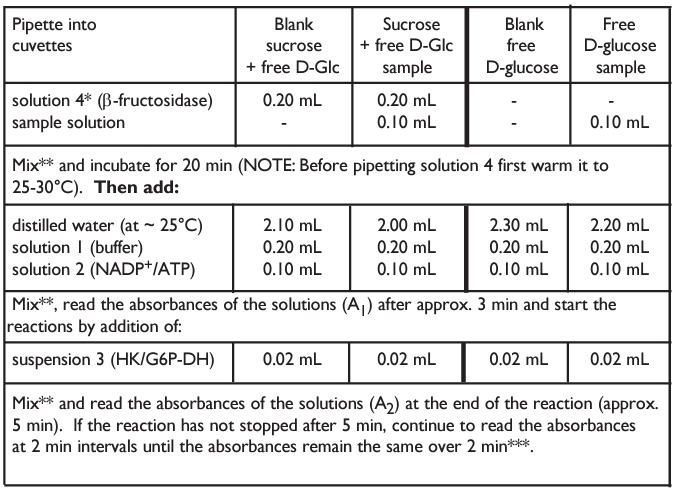
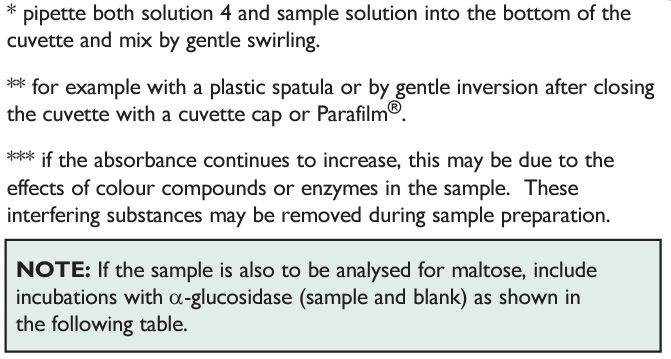
- 操作流程-葡萄糖和麥芽糖加上蔗糖 PROCEDURE (for D-glucose and maltose plus sucrose)

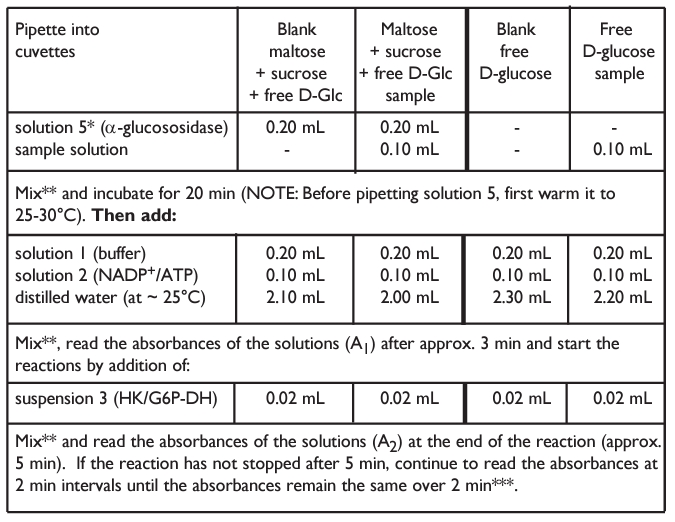

- 樣品準備 (SAMPLE PREPARATION)
1. Sample dilution.
The amount of D-glucose or maltose present in the cuvette (i.e. in the 0.2 mL of sample being analysed) should range between 4 and 80 μg (sucrose in the sample taken should range between approx. 8 and 160 μg). The sample solution must therefore be diluted sufficiently to yield a D-glucose concentration between 0.04 and 0.8 g/L.
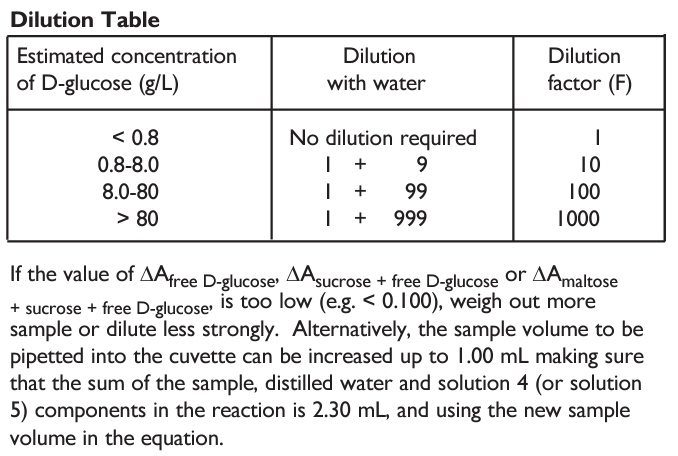
2. Sample clarification.
a. Solutions:
1️⃣Carrez I solution. Dissolve 3.60 g of potassium hexacyanoferrate (II) {K4[Fe(CN)6].3H2O} (Sigma cat. no. P9387) in 100 mL of distilled water. Store at room temperature.
2️⃣Carrez II solution. Dissolve 7.20 g of zinc sulphate (ZnSO4.7H2O) (Sigma cat. no. Z4750) in 100 mL of distilled water. Store at room temperature.
3️⃣Sodium hydroxide (NaOH, 100 mM). Dissolve 4 g of NaOH in 1 L of distilled water. Store at room temperature.
b. Procedure:
Pipette the liquid sample into a 100 mL volumetric flask which contains approx. 60 mL of distilled water, or weigh sufficient quantity of the sample into a 100 mL volumetric flask and add 60 mL of distilled water. Carefully add 5 mL of Carrez I solution, 5 mL of Carrez II solution and 10 mL of NaOH solution (100 mM). Mix after each addition. Fill the volumetric flask to the mark, mix and filter.
3. General considerations.
(a) Liquid samples: clear, slightly coloured and approximately neutral, liquid samples can be used directly in the assay.
(b) Acidic samples: if an acidic sample is to be used undiluted (such as red wine or coloured fruit juice), the pH of the solution should be increased to approx. 7.6 using 2 M NaOH, and the solution incubated at room temperature for 30 min.
(c) Carbon dioxide: samples containing carbon dioxide should be degassed by increasing the pH to approx. 7.6 with 2 M NaOH and gentle stirring, or by stirring with a glass rod.
(d) Coloured samples: an additional sample blank, i.e. sample with no HK/G6P-DH should be performed in the case of coloured samples.
(e) Strongly coloured samples: if used undiluted, strongly coloured samples should be treated by the addition of 1 g/100 mL of polyvinylpolypyrrolidone (PVPP). Stir for 2 min and then filter.
(f) Solid samples: homogenise or crush solid samples in distilled water and filter if necessary.
(g) Samples containing fat: extract such samples with hot water at a temperature above the melting point of the fat, e.g. in a 100 mL volumetric flask. Adjust to 20°C and fill the volumetric flask to the mark with water. Store on ice or in a refrigerator for 15-30 min and then filter. Discard the first few mL of filtrate and use the clear supernatant (which may be slightly opalescent) for assay. Alternatively, clarify with Carrez reagents.
(h) Samples containing protein: deproteinise samples containing protein with Carrez reagents.
商品特色
商品規格
- 商品規格(100個檢測反應)
Kits suitable for performing 34 assays of maltose, sucrose and D-glucose are available from Megazyme.
Bottle 1:
Buffer (25 mL, pH 7.6) plus sodium azide (0.02% w/v) as a preservative.
Stable for > 2 years at 4°C.
Bottle 2:
NADP+ plus ATP.
Stable for > 5 years below -10°C.
Bottle 3:
Hexokinase plus glucose-6-phosphate dehydrogenase suspension, 2.25 mL.
Stable for > 2 years at 4°C.
Bottle 4:
β-Fructosidase in sodium citrate buffer (pH 4.6),
lyophilised powder.
Stable for > 2 years below -10°C.
Bottle 5:
α-Glucosidase in sodium citrate buffer (pH 6.6),
lyophilised powder.
Stable for > 2 years below -10°C.
Bottle 6:
D-Glucose standard solution (5 mL, 0.4 mg/mL).
Stable for > 2 years at room temperature.
